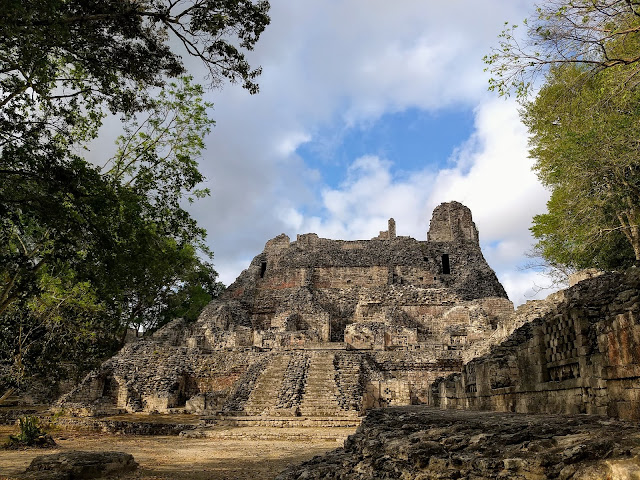The drive from Bacalar to Xpujil (pronounced "ish-poo-heel)" is 120 kilometers (75 miles) on mostly an excellent highway, though it needs some repaving after leaving the state of Quintana Roo and entering the state of Campeche.
CHICANNÁ - The ruins of Chicanná ("House of the Serpent Mouth") are five minutes up the road from our hotel and about 9 kilometers (5 1/2 mi.) from the charmless town of Xpujil. The most exciting structure in this archaeological zone is a temple-residence whose doorway is framed by a "monster mouth," a type of architecture seen at other Mayan ruins. (note enormous teeth and eyes in photo below).
 |
| ("CASA DE LA BOCA DE CULEBRA") - CHICANNÁ - ZONA ARCHEOLÓGICA - CAMPECHE |
 |
| ZONA ARCHAEÓGICA DE BECÁN, CAMPECHE |
XPUJIL - Later the same day - Xpujil ("tail of the cat") archaeological zone - 22 km. (13 mi.) south of the town. Named for the reed-like vegetation nearby, it is most noted for its three majestic towers.
 |
| CAMPECHE - ZONA ARCHAEOLÓGICA ZONA DE XPUJIL - INTERPRETACIÓN ARTÍSTICA |
 |
| CALAKMUL - GRAN PIRÁMIDE - |
 |
| VISTA DEL BOSQUE DEL GRAN PIRÁMIDE - CALAKMUL, CAMPECHE - VIEW OF BIOSPHERE HALF-WAY UP |
VOLCÁN DE MURCIÉGALOS On our last afternoon in the archaeological zone, we drive west 30 minutes to "el Volcán de Murciélagos" ("Volcano of Bats"). Parking just off the highway, we walk 200 meters (650 feet) up a narrow dirt path surrounded by tall trees, arriving at the precipice of a cordoned off, deep cave. Scientists refer to it as a cenote. At dusk, two large birds resembling kingfishers, screech as they flap down onto branches above us and wait. Minutes later, resembling a dark tornado, an estimated 4 to 5 million small bats begin to swirl out of this black hole in the earth. They will fly as far as Guatemala, 35 km. (22 mi.) away, most of them returning before daylight.
 |
| VOLCÁN DE MURCIÉGALOS- CAMPECHE |
The next morning, we begin the drive back to Chethumal. Wanting to avoid spending any more time than necessary there, we visit two more archaeological sites en route.
EL HORMIGUERO: ("The Anthill") No anthills in sight, but there are unexcavated mounds everywhere. In a remote and very much unvisited location,the most imposing structure is a tall temple with a "monster mouth" entrance at the top. High above us in the surrounding trees, two families of spider monkeys frolic and shake branches at us.
 |
| EL HORMIGUERO |
KOHUNLICH: (English - "Cohune Ridge"where cohune palm grew). Sixty km (37 miles) from Chetumal, Quintana Roo. The site is large and contains a number of plazas, pyramids and a large ball court. The main attraction here are the six large stucco masks, some as tall as 2 1/2 meters (8 feet), depicting Maya kings or the Maya Sun God, "Kinich Ajaw. The eyes of the masks all have a sun sign that face west. Gazing at them, they look starry eyed.
 |
| KOHUNLICH, QUINTANA ROO |
At all the Mayan and Aztec ruins we have visited in Mexico and Guatemala, there are almost always
faded splashes of crimson on some of the remaining stucco. These magnificent cities were once painted in brilliant colors, but time and erosion have erased almost all traces. At the entrance to some of the locations, signs posted with overviews of the Mayan civilization note that these cities were "built only by Mayans without the assistance of extraterrestrials." There is an absence of tourists at most of the archaeological sites we visited. With the exceptions of Calukmal and Kohunlich, where there were only six or eight other people, we were the only humans in the forests.
 |
| CALAKMUL |
We return from our ten-day adventure to cloudy skies and high humidity in Puerto Vallarta. Light drizzle follows for days. In the early evening of May 27th we hear the first electric buzz in our garden of a solitary cicada. It rains that night, signaling the beginning of their courting and the three month rainy season.
MASCOTA: In Spanish, the word means "pet." In the Teco language the name was "amaxacotlán mazacotla," which means "place of deer and snakes." The conquering Spaniards called it "Valley of the Deer." It is now very much horse country.
 |
| MASCOTA |
 |
| TEMPLO DE LA SANGRE PRECIOSA -MASCOTA |
 |
| VOLCÁN EL MOLCAJETE - MASCOTA |
CLINIC IN MASCOTA - MAY 22-25
Unable to attend as I was traveling. All photos were taken by vet tech/education director, Leslie Caratachea. Fundación Amigos de los Animales Mascota organized volunteers and lunches. The clinic took place in the very attractive Club de Leones (Lions Club) on the main street of town. This is our third annual visit to Mascota.
STERILIZATIONS AT CLINIC IN MASCOTA: MALE DOGS - 15; FEMALE DOGS - 21; MALE CATS - 13; FEMALE CATS - 37 TOTAL: 156!
 |
| CLÍNICA EN MASCOTA - CLUB DE LEONES |
PLUS PREGNANCIES TERMINATED FOR:
1 CAT WITH 6 FETUSES; 1 CAT WITH 5 FETUSES; 1 CAT WITH 4 FETUSES; AND TWO CATS WITH 3 FETUSES EACH - TOTAL: 21 ANIMALS NOT BORN TO SUFFER
This clinic was underwritten by an anonymous donation of $10,000 USD, which pays for 5.56 PEACEAnimals clinics. Mascota was the second clinic to date underwritten by this generous donation.
DONATIONS AT CLINIC IN MASCOTA: 1,230 PESOS
DONATIONS TO PEACEANIMALS:
GreaterGood.Org - $2,002.00 USD
Bebe Schweppe - $5,000 USD
Michael Turner - $50 USD (monthly)
In 2018, PEACEAnimals sterilized 5,792 cats and dogs.
HORARIO/SCHEDULE:
|




















No comments:
Post a Comment